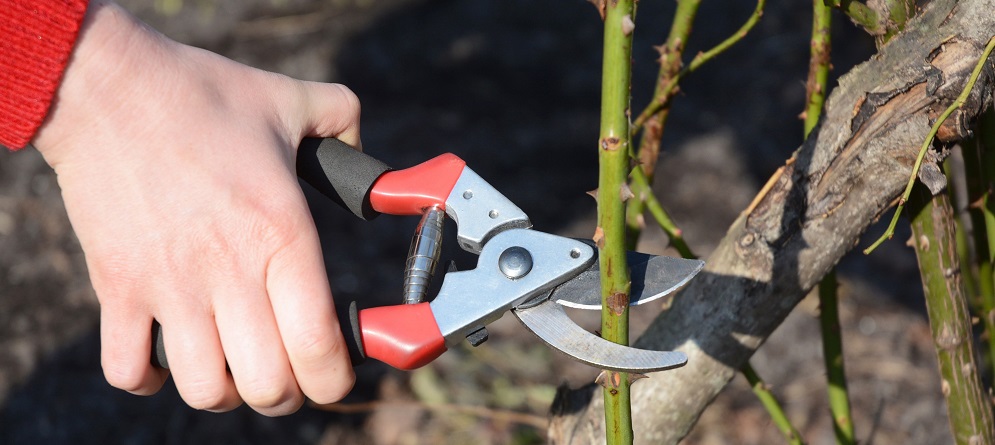Mid-February is one of the busiest times in the garden-we have plants that have died back this winter to cut back, and most importantly, it is time to prune our roses! Timing is important with all pruning endeavors, and roses should be pruned before they have started to put out new growth and expended precious reserves they will need to put out spring growth and blooms.
I have talked to many people who are hesitant to prune roses, thinking that they might harm them. Trust me, roses are tougher that you think! Follow a few guidelines, and before long you will become more confident in your rose pruning skills.
Here are a few things to do before you get started:
- Determine which type of rose you have. Hybrid Tea, Floribunda, and Grandiflora roses are pruned differently than shrub roses such as Knockouts, Drift and Flower Carpet, and also differently than Climbers.
- Have your hand pruners and loppers cleaned and sharpened. Have some 70% alcohol or hydrogen peroxide available for disinfecting tools between plants.
- Have Elmer’s glue handy to seal cuts on large canes to exclude cane borers.
- Have a rake and lawn bags ready for clean-up.
- And always, have some Rose gloves for hand protection!
Now, to get started: Click HERE for diagram
Hybrid Tea and Grandiflora Roses:
- Work from the ground up. Identify the oldest canes (they will be gray and woody) and remove them. Identify the newer green canes. These are the ones that will produce the biggest flowers this year.
- Remove any “sucker” growth that may have emerged from below the graft union. (the swollen part of the trunk near the base of the plant) These shoots will not produce the same flowers as the top of the plant and waste valuable energy.
- Remove crossing branches to open up the center to light and air circulation. Remove branches that are crowding each other. Select strong, healthy canes to form the structure for your rose.
- Now decide how far back to prune the rose. Roses are pruned much more severely in Northern climates, as roses die back farther there. It is reasonable to cut back roses in Central Texas about 1/3 of the way back from the top. You have chosen the strongest canes, so now find a bud on each cane that is facing OUT from the shrub. This bud will continue to grow OUT and help keep the center of the shrub open. Make the cut ¼” above this bud at an angle, with the high side of the slant above the bud. Do this to all remaining canes.
- Remove all growth thinner than a pencil. Seal all cuts larger than a pencil with a drop of Elmer’s glue to prevent cane borer entry.
- Stripping all leaves at this time will prevent many insect and disease problems that may have overwintered on the plant.
- Locate the graft union (that swollen place towards the base of the plant) and use a wire brush to gently remove the gray scaly woody stuff on the bud union. (Rose lore says that this encourages new sprouts from the bud union on the graft.)
- Last, but not least, CLEAN UP, CLEAN UP, CLEAN UP!!!!! Do I sound like your Mom yet? This step is SO important, I cannot stress it enough. Remove dead leaves, petals, clippings and weeds. DO NOT COMPOST! Besides not decomposing well, rose clippings will have overwintering insects and disease that does not belong in your compost pile.
Floribunda Roses:
- Follow the basic pruning guidelines above, but prune more lightly and do not worry about removing thin stems.
Knockout Roses and Ground Cover Roses:
- Knockout Roses are “shrub roses”, and like pruning shrubs, how much to prune depends on how tall you want them to be in the summer.
- First, prune out any dead branches and any that cross in the middle to open up the center for light and air circulation.
- You can easily use hedge shears to prune Knockout Roses, reducing the height to about 16” lower than where you want to see the first flowers appear.
- When you are done, CLEAN UP, CLEAN UP, CLEAN UP! (see description above)
- Knockout Roses may be pruned in the spring and summer as well. Use hand pruners or hedge shears periodically to “dead head” after a large bloom, or to reduce the size.
- Prune Knockout roses again in August to encourage fall blooms. Use hedge shears to remove no more than 1/3 of the growth. Follow by fertilizing with organic fertilizer such as Maestro Gro Rose Food.
Climbing Roses: Climbing Roses that bloom only in the spring should be pruned AFTER they bloom, as they bloom on old wood. Climbing roses that bloom continuously may be pruned in February, and also throughout the season. Do not prune until the rose is at least 2-3 years old.
- Locate the oldest, woodiest cane and remove at ground level. These canes will be the least productive, and will compete with new canes for water and nutrients. Choose the cane you want to remove, cut it at the base and follow it up the plant, cutting sections of it at intervals until the entire cane has been removed.
- Do not remove more than one-third of the canes at any one time. If you have let your climber go for many years, prune out the old canes gradually each year.
Groundcover Roses: These roses, such as the low-growing Drift and Flower Carpet varieties, are easily pruned with hedge shears in
February and also throughout the growing season. Do not remove more than one-third of the growth at one time.
